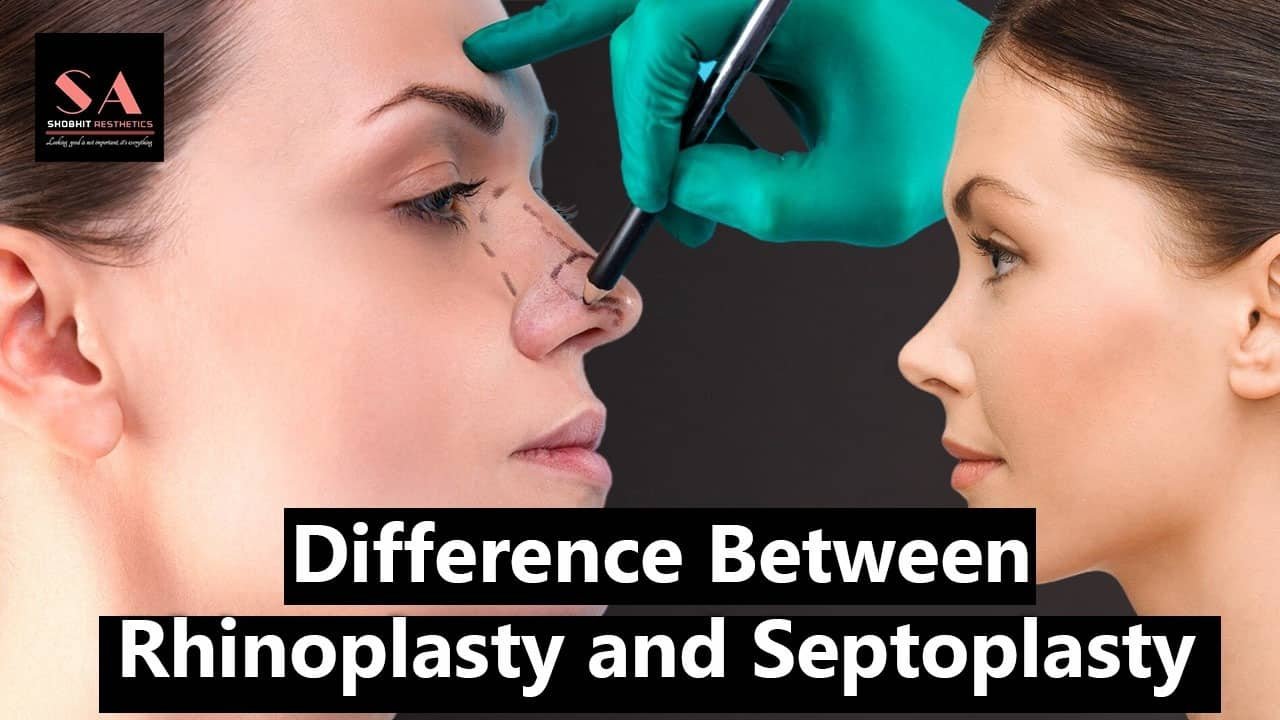
People sometimes confuse the terms Rhinoplasty and septoplasty and use them interchangeably when referring to what is most commonly called a nose job. However, the two are not the same. They are sometimes performed in conjunction with one another.
One is a more cosmetic procedure that is sometimes done for a medical reason, while the other is a medical procedure for a cosmetic reason. If you have aesthetic or functional concerns about your nose, understanding the difference between Rhinoplasty and septoplasty will help you choose the best treatment option.
Both surgical procedures target the nose but have different goals. Would you still like some clarification about the two methods? Let's discuss them in detail one by one to understand them better.
Understanding Septoplasty Procedure
To understand this procedure better, it is important to understand what part of the nose it targets: the nasal septum. A nasal septum is a wall that divides the nose into two chambers. When the septum is crooked or not in the center, it causes one nasal passage to be smaller than the other, commonly known as a deviated septum.
Unfortunately, a deviated septum is extremely painful and uncomfortable. A septoplasty in Delhi is a procedure that is performed to deal with such intolerable symptoms and make the septum straight.
The reason for this procedure is simple, but how do you know that you have a deviated septum?
Here are some symptoms that you might be suffering from:
Difficulty in breathing through the nose
Frequent nosebleeds
Snoring
Dry mouth
Poor sleep
Nasal congestion
Headaches
Frequent sinus congestion
Uncontrolled nosebleeds
Snoring due to nasal blockage
Some people with this condition may never experience problems. For others, it causes extreme discomfort and frustration. If you find it too difficult to function during the day and sleep at night, your doctor will probably suggest a septoplasty.
How is septoplasty performed?
The surgery is performed under local or general anesthesia.
The surgeon will make a small incision inside the nostrils, allowing them to access the nasal septum.
From there, the surgeon will correct the septum by repositioning it to the middle of your nose without breaking the nasal bones.
The incisions are closed with sutures that dissolve on their own with time.
To prevent the bleeding, your care team will place bandage-like material called packing in your nose.
Who is a good candidate for septoplasty?
If the nasal septum deviation is severe, it can obstruct the airflow in one or both nasal passages, resulting in various issues. These may include snoring, frequent sinus infections, sleep apnea, and respiratory problems.
While certain medications, such as decongestants and antihistamines, are commonly used to alleviate symptoms, they may have unwanted side effects, such as increased blood pressure (in the case of decongestants) and drowsiness (in the case of antihistamines). Additionally, these medications may not provide sufficient relief.
If your symptoms significantly impact your daily life, it is advisable to consult a nose sinus specialist and consider septoplasty surgery as a long-lasting solution to achieve relief.
What are the advantages of septoplasty?
Improved breathing
Alleviation of sinus issues
Better sleep quality
Enhanced physical and mental well-being
Improved exercise and athletic performance.
Understanding Rhinoplasty Procedure
Alternatively, Rhinoplasty, also known as a nose job, is a surgical procedure to enhance the nose's appearance. It can be done by changing the shape and size of the nose. It is performed to address the aesthetic concerns of the patient, like humps or bumps, a drooping or enlarged nasal tip, wide nostrils, or nasal asymmetry.
Rhinoplasty is for the people :
Who are not happy with the shape and size of their nose
Whose nose is not in good shape
Repair broken nose
Correct a congenital abnormality.
Who have nostrils that are too wide, too small, too large, or turn upward
Who have noticeable dips or bumps on the bridge of your nose
Who have big or small noses and not a good facial balance
Types of Rhinoplasty
There are two types of rhinoplasty procedure:
Open: Open Rhinoplasty is a procedure for major nose reshaping. Your surgeon will make incisions to separate the skin of your nose from the bone and cartilage, allowing them to see the anatomy of the nose completely.
Closed: It is a minor nose reshaping procedure. Your surgeon will make incisions within your nose to separate your skin from the bone and the cartilage to reshape it.
Other types of Rhinoplasty include:
Cosmetic Rhinoplasty: It improves the appearance of your nose and face.
Filler Rhinoplasty: It uses dermal fillers to fill the dips and irregularities in your nose.
Functional Rhinoplasty: It is used to treat a nose that has faced traumatic injuries. It is a type of reconstructive surgery that is also used to treat congenital disabilities.
Secondary Rhinoplasty: Revises or corrects any problems after the first rhinoplasty surgery. These problems can be minor but are often more complex for your surgeon to repair.
How is Rhinoplasty performed?
The procedure can be performed under general or local anesthesia.
Your surgeon will make an incision inside your nostrils. You can also have an incision across the base of your nose if you get an open rhinoplasty.
He will raise the skin, covering your nasal bones and cartilage.
The surgeon will next add or rearrange the underlying bone and cartilage to create a new shape for your nose.
The surgeon will then replace the skin covering your nasal bone and cartilage.
Small sutures are used to secure your skin in place. The total surgery can take around one to three hours.
What are the advantages of Rhinoplasty?
The advantages of Rhinoplasty are:
Change the shape and size of your nose.
Improve your facial appearance.
Correct any structural abnormalities of your nose
Improve how you breathe out of your nose.
Rhinoplasty vs Septoplasty
Feature
Rhinoplasty
Septoplasty
Purpose
Cosmetic improvement of the nose
Corrects deviated septum to improve breathing
Focus Area
The external structure of the nose
The internal structure of the nose
The goal of the surgery
Enhancing aesthetics of the face, fixing nasal deformities
Improving the airflow and nasal function by correcting the septum
candidates
Who want to improve their nose aesthetically
Those who have breathing difficulties due to deviated septum
Procedure
Reshaping nasal bone and cartilage
Reshaping deviated septum
Recovery time
1 to 2 weeks and 6 months for full results
1 to 2 weeks
Scarring
Minimal scarring
No visible scarring
Benefits
It enhances your appearance and improves your self-confidence
Improves nasal breathing and blockages
Cost
High because it is a cosmetic procedure
Lower than rhinoplasty
Rhinoseptoplasty: When you need to improve both nasal function and appearance
Rhino-septoplasty or Septorhinoplasty is a combined technique of simultaneously performing both septoplasty and rhinoplasty surgeries. This helps patients simultaneously improve breathing difficulties (function) and their nose's external appearance (cosmetic). It also allows them to heal post-operatively within one recovery phase.
It is often performed on patients with crooked noses, congenital defects, and other nose deformities caused by trauma or injury.
Benefits of Combined Surgery
Both aesthetic and functional concerns can be addressed in one surgery.
Patients have the advantage of undergoing only one recovery period instead of two.
The combined surgery is cost-effective
Save time and money
Achieve facial symmetry
Making the Decision: Rhinoplasty, Septoplasty, or Both
There are several factors to consider while undergoing rhinoplasty, septoplasty, or both. First, it is important to understand if your concern is about the function of your nose or its aesthetic appearance. If your problem is the former, septoplasty is the right procedure. If you want the latter, then consider opting for a rhinoplasty. And if your goal is to improve both, septorhinoplasty is the correct procedure for you.
Remember to consult with a qualified surgeon before deciding on a procedure. They’ll be able to discuss your desired outcomes, explain the potential benefits and risks of any procedure you’re considering, and provide expert guidance based on your specific circumstances.
Choose the best nose job procedure with the best cosmetic surgeon in Delhi.
Only a qualified plastic surgeon will be able to make the medical decision of which nose surgery job is right for you. Dr Shobhit Gupta is a board-certified plastic surgeon with more than a decade of experience in aesthetic nasal surgery.
Considered the best rhinoplasty surgeon in Delhi, he is known for giving the most natural results without any visible scarring. If you have more concerns about nose surgery, rhinoplasty, or septoplasty, please book a consultation with him today.
Besides these procedures, he is also highly experienced in performing other plastic surgeries like breast enhancement procedures, breast reduction procedures, botox, lip fillers, and more.


